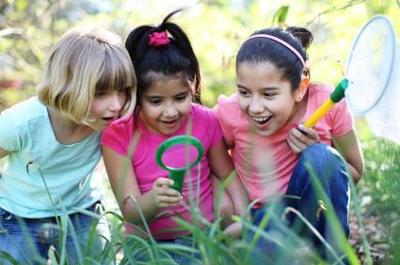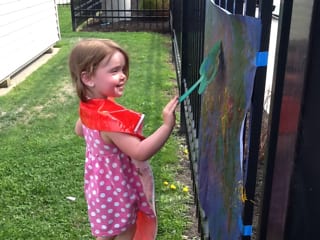May 26, 2015
Differentiating Choose Your Own Adventure Week
Differentiating Choose Your Own Adventure
*Please note* This blog is intended for campers (ages 3+) but toddler teachers may find some ideas easy to adapt. Toddler teachers are also encouraged to review the toddler-specific differentiation ideas found in the Curriculum Notes.
Imagination and creativity take the lead this week as each student will choose their own adventure! Over the course of the week, you have an opportunity to lead structured activities that demonstrate how one uses their imagination to come up with ideas to put into play. You’ll extend these activities into independent play – encouraging children to practice the same based on their own ideas and ambitions. Here are some examples of how to adapt activities to compliment a variety of learning styles and interests.
Scavenger Hunt – Create multiple scavenger hunt lists with consideration of your campers. Do you have some Lego lov ers? Garden enthusiasts? Superhero fanatics? These are fun things that could be incorporated into the game that will completely change the engagement level in a wonderfu l way. Superhero photos or figurines could be hidden around the outdoor space as well as garden tools or photos. Try putting together a Lego scavenger hunt – create a few simple Lego creations and take photos of them ahead of time (house, person, dog, etc.). Then, place the photos along with the pile of blocks that created it somewhere to find. Campers will need to build the structure and take a picture of it to claim it on their scavenger hunt list. Make the experience more efficient by creating your scavenger hunt lists through photos and add the albums to your photo gallery!
ers? Garden enthusiasts? Superhero fanatics? These are fun things that could be incorporated into the game that will completely change the engagement level in a wonderfu l way. Superhero photos or figurines could be hidden around the outdoor space as well as garden tools or photos. Try putting together a Lego scavenger hunt – create a few simple Lego creations and take photos of them ahead of time (house, person, dog, etc.). Then, place the photos along with the pile of blocks that created it somewhere to find. Campers will need to build the structure and take a picture of it to claim it on their scavenger hunt list. Make the experience more efficient by creating your scavenger hunt lists through photos and add the albums to your photo gallery!
Open-Ended Art – This space should be an exciting area to explore on a daily basis. Make sure y ou give children at least 2 different options for arts and crafts with some flexible features to make them their own. For example – a simple open-ended indoor or outdoor easel experience should be always be equipped with many paint colors and painting tools to choose from (along with smocks!). Make it engaging by adding pieces that appeal to your campers. Plastic gloves may help children who are routinely resistant to get involved in the mess more likely to try, super messy tools such as flyswatters, rubber bands, and spray bottles will attract the art enthusiasts who like to jump right in, and 3D materials (small boxes, tissue paper, yarn, and pipe cleaners) are appealing to more kinesthetic learners.
ou give children at least 2 different options for arts and crafts with some flexible features to make them their own. For example – a simple open-ended indoor or outdoor easel experience should be always be equipped with many paint colors and painting tools to choose from (along with smocks!). Make it engaging by adding pieces that appeal to your campers. Plastic gloves may help children who are routinely resistant to get involved in the mess more likely to try, super messy tools such as flyswatters, rubber bands, and spray bottles will attract the art enthusiasts who like to jump right in, and 3D materials (small boxes, tissue paper, yarn, and pipe cleaners) are appealing to more kinesthetic learners.
Adventure Theatre – This idea is an awesome way to build in language, vocabulary, and fluency through play! The best way to unveil children’s interest in theatre is to find out what they like to watch. Make a list of favorites and then circle the top 4 or 5 suggestions and turn them into small groups. Invite these “teams” to collect props in a box that they’ll need for the performance. Then, have each team choose a “writer” to record the story they want to tell. Teachers, you may need to become this writer. The next steps are to rehearse, create costumes and sets, and perform! If you introduce this project as being something that lots of people will see, children may be more apt to participate. Consider recording the performances and playing them on the center TV through the tablets! With all of the different roles in this project (writer, costume designers, set designers and builders, narrator and characters, and music/instrument designer) there’s something for every learning style!

 1.866.668.5111
1.866.668.5111  6:30 am - 6:00 pm
6:30 am - 6:00 pm 
 Give a Happy High Five!
Give a Happy High Five!


